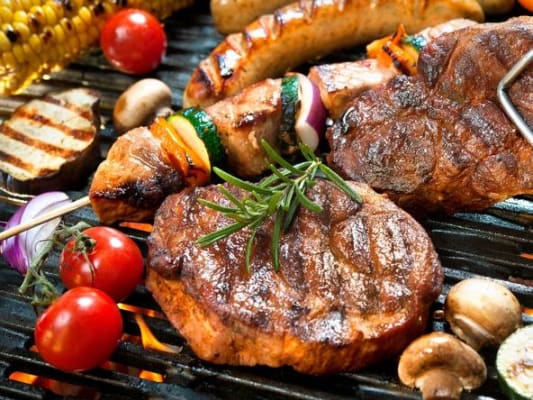Guide to Safe Grilling Practices

This content is courtesy of Mayo Clinic, the No. 1 hospital in the nation according to U.S. News & World Report. Middlesex Health is a member of the Mayo Clinic Care Network. This relationship provides us with access to information, knowledge and expertise from Mayo Clinic.
If you are looking forward to a weekend cookout, make sure to keep foodborne bacteria and germs off your guest list. Dr. Nipunie Rajapakse, a Mayo Clinic pediatric infectious diseases physician, says warmer temperatures are when foodborne germs thrive and illnesses peak.
Dr. Rajapakse offers a few important safety tips to keep your family and friends safe from foodborne illness when you’re around the grill:
Cooking meats destroys harmful germs.
Raw or undercooked meats can make you sick. When grilling meats, it’s important to ensure proper temperatures are reached before eating. Use a meat thermometer to check the temperatures.
Safe grilling temperatures for meat are:
- 145 F for steaks; roasts; and chops, such as lamb, pork and veal.
- 160 F for ground beef.
- 165 F for chicken and turkey.
Keep food separated.
Even if you keep your food separated, contaminated hands can easily spread bacteria from one food to another.
"Keep your raw meat and poultry products separate from your vegetable products such as salads that you may be serving without cooking or heating. That ensures that you’re not cross-contaminating your food with bacteria that may make people sick," Dr. Rajapakse says.
Practice good hand hygiene.
Wash your hands for at least 20 seconds with soap and water.
"Ensure that you are doing a really good job of washing your hands. This is especially important if you’re going between preparing meat and other foods. You need to ensure that you remove any traces of bacteria from your hands before you start preparing foods that you may not be cooking until later or won't be subjecting to a high temperature."
Properly store foods.
"The other important thing during grilling season is to ensure that you are storing or keeping food at a safe temperature," says Dr. Rajapakse. "We want to encourage people not to keep food in the danger zone, which is usually between 40 to 140 degrees Fahrenheit. That’s the ideal temperature for bacteria to reproduce and replicate. And when your food sits at that temperature for a prolonged period, you increase the risk that people might get sick from eating it."
Make sure leftovers get to the refrigerator. Food should sit out at room temperature for no longer than two hours. That time should be reduced to one hour if it is warmer than 90 F outside.
More Stories
Protect Those Eyes on the Sky
While a solar eclipse is a momentous occasion, it's something eye experts say you need to enjoy safely.
Heart-Smart Cranberry Apple Crisp Recipe for the Holidays
Cranberries have become a Thanksgiving dinner staple. How about making a heart-smart cranberry apple crisp this year?